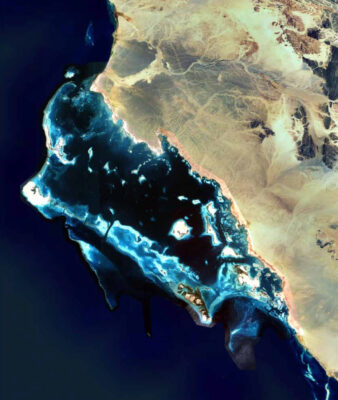NASA Partnership
Building a Global Map of Coral Reefs

The Khaled bin Sultan Living Oceans Foundation (KSLOF) has partnered with NASA’s Ames Research Center in California’s Silicon Valley to help NASA create detailed maps of the world’s coral reefs.
The Space Act Agreement between KSLOF and NASA gives the agency access to 65,000 square kilometers of coral reef habitat maps from the foundation’s Global Reef Expedition (GRE), one of the largest surveys of coral reefs ever completed. These maps were created from a combination of satellite imagery and underwater surveys to ensure their accuracy. Now, NASA is using this information to train supercomputers to map coral reefs. This will allow them to create high-resolution maps of coral reefs without having to conduct underwater surveys in the field.
NASA will use KSLOF’s ground-truthed coral reef maps from the GRE as training data, feeding it into their NeMO-Net neural network running on the Pleiades supercomputer at NASA Ames. This system uses a combination of satellite imagery and next-generation underwater imaging technology to create detailed maps of coral reefs.
With the information from the GRE, NeMO-Net’s maps will become more accurate, giving researchers and environmental managers better information about what’s happening to coral reefs and how to protect them at a time when they are experiencing unprecedented anthropogenic pressures.
To assemble the dataset that will train the NeMO-Net neural network, KSLOF spent ten years mapping and surveying coral reefs on the Global Reef Expedition. This research mission circumnavigated the globe to survey and map coral reefs in the Atlantic, Pacific, and Indian Oceans as well as the Red Sea. In addition to reports on the state of the reefs, the Expedition resulted in the creation of high-resolution coral reef habitat maps of about one-fifth of the world’s coral reefs. These maps are able for anyone to view on the foundation’s World Reef Map.
This partnership will assist NASA in creating maps of all the coral reefs in the world and tracking how reefs are changing over space and (eventually) through time, giving scientists around the world the insight needed to address the coral reef crisis.
How you can help
Help NeMO-Net learn by playing the NeMO-Net game! NeMO-Net is a single player iPad game where players help NASA classify coral reefs by painting 3D and 2D images of coral. Players can rate the classifications of other players and level up in the food chain as they explore and classify coral reefs and other shallow marine environments and creatures from locations all over the world!
Data from the NeMO-Net game is fed to NASA NeMO-Net, the first neural multi-modal observation and training network for global coral reef assessment. NeMO-Net uses game data to classify and assess the health of coral reefs around the world.
What’s Next
Enabled by the recently-executed Space Act Agreement with NASA, KSLOF and NASA are now embarking on additional research projects together. A new multi-year study mapping reef biodiversity entitled ‘The Marine Biodiversity and Scaling Project’ (MarineVERSE) was recently launched, and we look forward to working with NASA and our partners at the University of Miami’s Rosenstiel School of Marine and Atmospheric Science (RSMAS) and their Aircraft Center for Earth Studies (ACES) on this project.